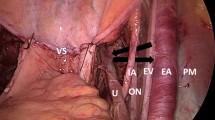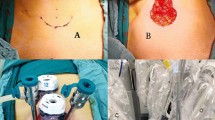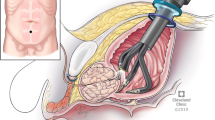Abstract
Inguinal hernia is one of the long-term complications requiring surgical interventions after retropubic radical prostatectomy (RRP), and its incidence has been reported to range from 12 to 21%. The number of open gasless laparoendoscopic single-site surgery, especially minimum incision endoscopic radical prostatectomy (MIES-RRP) is increasing in Japan. The incidence of post-operative inguinal hernia was compared between conventional RRP and MIES-RRP. The medical records of 333 patients who underwent conventional RRP (n=214) or MIES-RRP (n=119) with pelvic lymphadenectomy at our hospital were retrospectively evaluated. There were no significant differences between the two groups in age, pre-operative PSA levels, or previous major abdominal surgery (cholecystectomy, gastrectomy and colectomy), appendectomy or inguinal hernia repair. MIES-RRP was carried out with a 5–8-cm lower abdominal midline incision. Inguinal hernia developed postoperatively in 41 (19%) of the 214 men undergoing conventional RRP during mean follow-up of 58 months (range: 7–60 months). In contrast, 7 (5.9%) of the 119 men receiving MIES-RRP, developed inguinal hernia during mean follow-up of 21 months (range: 13–31 months). The hernia-free survival was significantly higher after MIES-RRP than after conventional RRP (P=0.037). Our results suggest that MIES-RRP is less associated with post-operative inguinal hernia than conventional RRP.
This is a preview of subscription content, access via your institution
Access options
Subscribe to this journal
Receive 4 print issues and online access
$259.00 per year
only $64.75 per issue
Buy this article
- Purchase on Springer Link
- Instant access to full article PDF
Prices may be subject to local taxes which are calculated during checkout

Similar content being viewed by others
References
Regan TC, Mordkin RM, Constantinople NL, Spence IJ, Dejter Jr SW . Incidence of inguinal hernias following radical retropubic prostatectomy. Urology 1996; 47: 536–537.
Marshall FF, Chan D, Partin AW, Gurganus R, Hortopan SC . Minilaparotomy radical retropubic prostatectomy: technique and results. J Urol 1998; 160: 2440–2445.
Kihara K, Kobayashi T, Kawakami S, Fujii Y, Kageyama Y, Masuda H . Minimum incision endoscopic surgery (mies) in japanese urology: results of adrenalectomy, radical nephrectomy and radical prostatectomy. Aktuelle Urol 2010; 41 (Suppl 1): S15–S19.
Walsh PC . Anatomic radical prostatectomy: evolution of the surgical technique. J Urol 1998; 160: 2418–2424.
Lepor H, Robbins D . Inguinal hernias in men undergoing open radical retropubic prostatectomy. Urology 2007; 70: 961–964.
Stranne J, Johansson E, Nilsson A, Bill-Axelson A, Carlsson S, Holmberg L et al. Inguinal hernia after radical prostatectomy for prostate cancer: results from a randomized setting and a nonrandomized setting. Eur Urol 2010; 58: 719–726.
Sekita N, Suzuki H, Kamijima S, Chin K, Fujimura M, Mikami K et al. Incidence of inguinal hernia after prostate surgery: open radical retropubic prostatectomy versus open simple prostatectomy versus transurethral resection of the prostate. Int J Urol 2009; 16: 110–113.
Ichioka K, Kohei N, Yoshimura K, Arai Y, Terai A . Impact of retraction of vas deferens in postradical prostatectomy inguinal hernia. Urology 2007; 70: 511–514.
Lodding P, Bergdahl C, Nyberg M, Pileblad E, Stranne J, Hugosson J . Inguinal hernia after radical retropubic prostatectomy for prostate cancer: a study of incidence and risk factors in comparison to no operation and lymphadenectomy. J Urol 2001; 166: 964–967.
Abe T, Shinohara N, Harabayashi T, Sazawa A, Suzuki S, Kawarada Y et al. Postoperative inguinal hernia after radical prostatectomy for prostate cancer. Urology 2007; 69: 326–329.
Hicks J, Douglas J, Eden CG . Incidence of inguinal hernia after radical retropubic, perineal and laparoscopic prostatectomy. Int J Urol 2009; 16: 588; author reply 588.
Stranne J, Hugosson J, Iversen P, Morris T, Lodding P . Inguinal hernia in stage m0 prostate cancer: a comparison of incidence in men treated with and without radical retropubic prostatectomy--an analysis of 1105 patients. Urology 2005; 65: 847–851.
Stranne J, Hugosson J, Lodding P . Inguinal hernia is a common complication in lower midline incision surgery. Hernia 2007; 11: 247–252.
Tsai PJ, Yu CC, Lee YH, Huang JK . Inguinal hernia after radical retropubic prostatectomy--experience of kaohsiung veterans general hospital. J Chin Med Assoc 2004; 67: 141–144.
Twu CM, Ou YC, Yang CR, Cheng CL, Ho HC . Predicting risk factors for inguinal hernia after radical retropubic prostatectomy. Urology 2005; 66: 814–818.
Koie T, Yoneyama T, Kamimura N, Imai A, Okamoto A, Ohyama C . Frequency of postoperative inguinal hernia after endoscope-assisted mini-laparotomy and conventional retropubic radical prostatectomies. Int J Urol 2008; 15: 226–229.
Stranne J, Hugosson J, Lodding P . Post-radical retropubic prostatectomy inguinal hernia: an analysis of risk factors with special reference to preoperative inguinal hernia morbidity and pelvic lymph node dissection. J Urol 2006; 176: 2072–2076.
Fukuta F, Hisasue S, Yanase M, Kobayashi K, Miyamoto S, Kato S et al. Preoperative computed tomography finding predicts for postoperative inguinal hernia: new perspective for radical prostatectomy-related inguinal hernia. Urology 2006; 68: 267–271.
Nomura T, Mimata H, Kitamura H, Fujikura Y, Akita Y, Yamasaki M et al. Lower incidence of inguinal hernia: minilaparotomy radical retropubic prostatectomy compared with conventional technique. A preliminary report. Urol Int 2005; 74: 32–37.
Rabbani F, Yunis LH, Touijer K, Brady MS . Predictors of inguinal hernia after radical prostatectomy. Urology 2011; 77: 391–395.
Ichioka K, Yoshimura K, Utsunomiya N, Ueda N, Matsui Y, Terai A et al. High incidence of inguinal hernia after radical retropubic prostatectomy. Urology 2004; 63: 278–281.
Nielsen ME, Walsh PC . Systematic detection and repair of subclinical inguinal hernias at radical retropubic prostatectomy. Urology 2005; 66: 1034–1037.
Watson DS, Sharp KW, Vasquez JM, Richards WO . Incidence of inguinal hernias diagnosed during laparoscopy. South Med J 1994; 87: 23–25.
Heydorn WH, Velanovich V . A five-year US Army experience with 36 250 abdominal hernia repairs. Am Surg 1990; 56: 596–600.
Sun M, Lughezzani G, Alasker A, Isbarn H, Jeldres C, Shariat SF et al. Comparative study of inguinal hernia repair after radical prostatectomy, prostate biopsy, transurethral resection of the prostate or pelvic lymph node dissection. J Urol 2010; 183: 970–975.
Yoshimine S, Miyajima A, Nakagawa K, Ide H, Kikuchi E, Oya M . Extraperitoneal approach induces postoperative inguinal hernia compared with transperitoneal approach after laparoscopic radical prostatectomy. Jpn J Clin Oncol 2010; 40: 349–352.
Arnbjornsson E . A neuromuscular basis for the development of right inguinal hernia after appendectomy. Am J Surg 1982; 143: 367–369.
Arnbjornsson E . Development of right inguinal hernia after appendectomy. Am J Surg 1982; 143: 174–175.
van Wessem KJ, Simons MP, Plaisier PW, Lange JF . The etiology of indirect inguinal hernias: congenital and/or acquired? Hernia 2003; 7: 76–79.
Author information
Authors and Affiliations
Corresponding author
Ethics declarations
Competing interests
The authors declare no conflict of interest.
Rights and permissions
About this article
Cite this article
Fukuhara, H., Nishimatsu, H., Suzuki, M. et al. Lower incidence of inguinal hernia after radical prostatectomy using open gasless endoscopic single-site surgery. Prostate Cancer Prostatic Dis 14, 162–165 (2011). https://doi.org/10.1038/pcan.2011.1
Received:
Revised:
Accepted:
Published:
Issue Date:
DOI: https://doi.org/10.1038/pcan.2011.1
Keywords
This article is cited by
-
Inguinal Hernias After Lower Midline Incision Surgery: Clues for Considering Inguinal Hernia in Females and Males: a Literature Review
SN Comprehensive Clinical Medicine (2022)
-
Incidence and risk factors of inguinal hernia after robot-assisted radical prostatectomy
World Journal of Surgical Oncology (2017)



